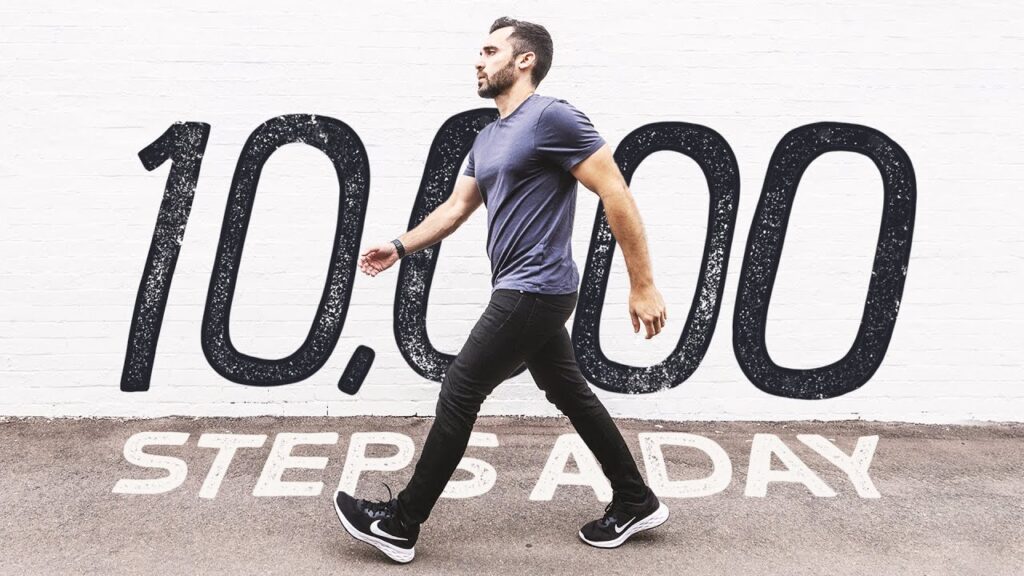If you’ve ever wondered how long it takes to achieve the recommended 10,000 steps a day, you’re not alone. Walking 10,000 steps has become a popular fitness goal for many, but the question remains: how much time does it actually take to reach this milestone? In this article, we’ll explore the average time it takes to walk 10k steps, factors that can impact your pace, and tips for incorporating more steps into your daily routine. So lace up your shoes and let’s get walking!

Factors Affecting the Time to Walk 10k Steps
Walking Speed
One of the key factors that affects the time it takes to walk 10k steps is your walking speed. A faster walking speed will obviously mean that you can cover more distance in a shorter period of time. On the other hand, a slower walking speed will naturally result in a longer walking time.
Terrain
The terrain you are walking on can also have a significant impact on the time it takes to complete 10k steps. walking on a flat surface, such as a paved road or track, will generally enable you to maintain a consistent speed and complete the 10k steps more quickly. However, if you are walking on uneven ground or encountering hills, it will naturally slow down your pace and increase the overall walking time.
Fitness Level
Your fitness level plays a crucial role in determining how quickly you can cover the 10k steps. Individuals who are physically fit and have good cardiovascular endurance will generally be able to maintain a faster walking speed and complete the distance more efficiently. On the other hand, those who are less fit may need to take more breaks and walk at a slower pace, extending the overall walking time required.
Age and Gender
Age and gender also have an impact on the time it takes to walk 10k steps. Generally speaking, younger individuals tend to have a faster walking speed and may cover the distance more quickly than older individuals. Additionally, men often have a naturally faster walking speed compared to women due to physiological differences. However, it is important to note that individual variations within age and gender groups exist, and these factors should not be seen as absolute determinants of walking speed.
Incline and Decline
Walking on inclines and declines can significantly affect the time it takes to complete 10k steps. Walking uphill requires more effort and can slow down your pace, effectively increasing the overall walking time. Conversely, walking downhill may allow for a faster pace and potentially reduce the time needed to complete the 10k steps. The varying exertion levels required during inclines and declines can greatly impact the overall walking time.
Weather Conditions
Weather conditions can also affect the time it takes to walk 10k steps. In hot weather, high temperatures can cause fatigue and dehydration, potentially slowing down your walking speed. Cold weather, on the other hand, may result in stiff muscles and decreased flexibility, impacting your overall pace. Rain, wind, and humidity can also make walking more challenging and slower. Extreme weather conditions, such as heavy snow or strong winds, might even make it unsafe to walk, further increasing the walking time or preventing the completion of 10k steps altogether.
Average Time to Walk 10k Steps
General Estimates
While there are various factors that can influence the time it takes to walk 10k steps, it can be helpful to have some general estimates. On average, for individuals with an average walking speed of around 3 miles per hour, it would take approximately 2 hours to complete 10k steps. However, this is a rough estimate, and the actual time may vary significantly based on individual factors such as fitness level and the terrain being covered.
Walking Speed
As previously mentioned, your walking speed is one of the main factors determining the time it takes to walk 10k steps. If you are able to maintain a faster walking speed, you can complete the 10k steps more quickly. On the other hand, if you prefer a more leisurely pace, it will naturally extend the overall walking time.
Terrain
The terrain you choose to walk on can have a notable impact on your walking time. Walking on a flat surface, such as a track or treadmill, is generally easier and allows you to maintain a consistent speed. As a result, you may be able to complete 10k steps in a shorter period of time. However, if you encounter uneven ground, hills, or stairs, it will slow down your pace and increase the overall walking time required.
Fitness Level
Your fitness level directly affects your walking speed and endurance, which in turn influences the time it takes to walk 10k steps. Individuals who are physically fit and engage in regular aerobic exercise are likely to have a faster walking speed and be able to complete the 10k steps more efficiently. Those who are less fit may need to take more breaks and walk at a slower pace, resulting in a longer overall walking time.
Age and Gender
Age and gender can also impact the time it takes to walk 10k steps. Generally, younger individuals tend to have a faster walking speed compared to older individuals. Additionally, men often have a naturally faster walking speed compared to women due to physiological differences such as muscle mass and stride length. However, individual variations within age and gender groups exist, so it is important to consider each person’s unique circumstances when estimating walking time.
Incline and Decline
Walking on inclines and declines can significantly affect the time it takes to complete 10k steps. Walking uphill requires more effort and can slow down your pace, effectively increasing the overall walking time. Conversely, walking downhill may allow for a faster pace and potentially reduce the time needed to complete the 10k steps. The varying exertion levels required during inclines and declines can greatly impact the overall walking time.
Weather Conditions
Weather conditions play a role in the time it takes to walk 10k steps. In hot weather, high temperatures can cause fatigue and dehydration, potentially slowing down your walking speed and extending the overall walking time. Cold weather may result in stiff muscles and decreased flexibility, impacting your pace as well. Rain, wind, and humidity can also make walking more challenging and slower. Extreme weather conditions, such as heavy snow or strong winds, might even make it unsafe to walk, further increasing the walking time or preventing the completion of 10k steps altogether.
Factors That Influence Walking Speed
Physical Fitness
Physical fitness is a major factor that influences walking speed. Regular cardiovascular exercise and strength training can improve your fitness level, allowing you to walk at a faster pace. Building endurance and strengthening your muscles can help you maintain a steady speed and reduce fatigue while walking. Additionally, improving flexibility through stretching and incorporating exercises that target mobility can also contribute to a faster walking speed.
Experience and Training
Experience and training can also impact your walking speed. Individuals who have been consistently walking or engaging in other forms of physical activity for an extended period of time tend to have greater efficiency and endurance, which can translate to a faster walking speed. Training programs specifically designed to improve walking performance, such as interval training and speed drills, can further enhance your walking speed over time.
Age and Gender
Age and gender can affect walking speed due to various physiological factors. In general, younger individuals have more efficient muscle function and greater cardiovascular capacity, contributing to a faster walking speed. Men tend to have greater muscle mass and a higher stride length, which can also result in a faster pace compared to women. However, individual variations within age and gender groups should be considered, as factors such as fitness level and overall health can influence walking speed as well.
Terrain
The terrain you are walking on has a direct impact on your walking speed. Walking on a smooth, flat surface allows for a more efficient and consistent stride, enabling you to achieve a faster pace. On the other hand, walking on uneven ground, such as trails or gravel pathways, can slow down your speed as you navigate through obstacles and adjust your stride accordingly. Uphill walking requires more effort and often results in a slower pace, while downhill walking may allow for a faster speed due to the assistance of gravity.
Weather Conditions
Weather conditions also play a role in walking speed. Hot weather can lead to increased fatigue and dehydration, potentially slowing down your pace. Cold weather may cause stiffness in your muscles, leading to a slower speed. Rain, wind, and humidity can create challenging conditions that require more effort to maintain a fast pace. It is important to adjust your walking speed accordingly and take precautions to stay safe and comfortable in varying weather conditions.
Terrain Impact on Walking Time
Flat Surface
Walking on a flat surface, such as a paved road or a treadmill, generally allows for a more consistent and efficient pace. The smooth and even terrain enables you to maintain a steady speed throughout your walk, resulting in a shorter walking time to complete 10k steps compared to other terrains.
Uneven Ground
Walking on uneven ground, such as trails or gravel pathways, can significantly impact your walking time. Uneven surfaces require adjustments to your stride and pace, potentially slowing down your overall speed. The need to navigate through rocks, roots, or other obstacles can also add to the challenge and increase the time it takes to complete 10k steps.
Hills and Inclines
Walking uphill or on inclines can significantly affect your walking time. Uphill walking requires more effort and may slow down your pace, resulting in a longer overall time to complete 10k steps. The steeper the incline, the greater the impact on your speed. It is important to note that hill training can be beneficial for building strength and endurance, but it may increase the time needed for completing the 10k steps.
Stairs
Walking up or down a set of stairs can also affect the time it takes to walk 10k steps. Climbing stairs requires increased effort and can naturally slow down your walking speed. Descending stairs, on the other hand, can be faster due to the assistance of gravity. However, navigating stairs can add to the complexity of your walk and potentially increase the overall time required.

Fitness Level and Walking Time
Effect of Aerobic Fitness
Aerobic fitness level has a direct impact on your walking time. Individuals with higher aerobic fitness levels tend to have a faster walking speed and better endurance, enabling them to complete 10k steps in a shorter time. Regular aerobic exercise, such as brisk walking, jogging, or cycling, can improve cardiovascular fitness and increase the efficiency of oxygen utilization by your muscles. This ultimately translates to a faster walking speed and reduced walking time.
Muscular Endurance
Muscular endurance is another important aspect of fitness that influences walking time. Having strong muscles, particularly in the lower body, allows you to maintain a steady and efficient walking pace for a longer duration. Strengthening exercises that target the legs, hips, and core can improve muscular endurance, enabling you to walk at a faster speed for an extended period of time.
Body Composition
Your body composition, specifically the ratio of muscle to fat, can impact your walking time. Higher muscle mass contributes to better walking speed and overall physical performance. This is because muscles are responsible for generating the force required to move your body, and having more muscle allows for more efficient movement and a faster pace. Conversely, a higher percentage of body fat can lead to increased body weight, potentially slowing down the walking speed and extending the time it takes to complete 10k steps.
Resting Heart Rate
Resting heart rate, which is the number of times your heart beats per minute at rest, can reflect your cardiovascular fitness level. Lower resting heart rates are often indicative of better cardiovascular health and fitness. Therefore, individuals with lower resting heart rates may have a more efficient cardiovascular system, enabling them to walk at a faster pace and complete the 10k steps in a shorter time.
Age and Fitness
Age and fitness level interact to influence walking time. Generally, younger individuals tend to have higher fitness levels and better muscular strength and endurance, leading to a faster walking speed. However, individuals of any age can improve their fitness through regular physical activity and exercise, ultimately resulting in a faster walking speed and reduced walking time. It is important to focus on maintaining an active lifestyle throughout all stages of life to optimize fitness and walking performance.
Age and Gender Differences
Age and Walking Speed
Age can affect walking speed, with younger individuals typically having a faster pace compared to older individuals. As we age, our muscle strength and endurance naturally decline, impacting walking speed. Older adults may also experience reduced flexibility and mobility, which further affects their gait and overall walking time. However, it is important to note that age is just one factor influencing walking speed, and individual variations within age groups exist.
Gender and Biomechanical Differences
Gender can also influence walking speed due to biomechanical differences between men and women. Men generally have a larger muscle mass and longer stride length, which can contribute to a faster walking pace. Women, on the other hand, tend to have a smaller muscle mass and shorter stride length, potentially resulting in a slower speed. However, it is essential to consider individual variations and not generalize based on gender alone. Each person’s unique fitness level, body composition, and overall health also play a significant role in determining walking speed.
Age and Fitness Level
The relationship between age and fitness level is crucial when considering walking time. As we age, it becomes increasingly important to maintain or improve our fitness level to mitigate the effects of age-related decline. Regular physical activity, including walking, can help individuals of all ages improve their fitness, making them more capable of completing 10k steps in a shorter time. Regardless of age, maintaining an active lifestyle and engaging in regular exercise is beneficial for overall health and well-being.
Health Conditions and Disabilities
Certain health conditions and disabilities may affect walking speed and overall walking time. Individuals with conditions that cause pain, limited mobility, or decreased muscle strength may have a slower walking pace and require more time to complete 10k steps. Additionally, disabilities that affect coordination, balance, or gait may also influence walking speed. It is important to consider these unique circumstances and make necessary accommodations to ensure a safe and enjoyable walking experience.

Impact of Incline and Decline
Walk Uphill
Walking uphill requires more effort and can significantly impact walking time. As you ascend an incline, you are working against gravity, which increases the intensity of your movement and slows down your pace. Uphill walking engages the muscles more intensely, especially the muscles of the lower body, as they must work harder to propel you forward. As a result, completing 10k steps on an uphill route will likely take more time compared to walking on a flat surface.
Walk Downhill
Walking downhill can influence walking time in a different way. Descending a decline allows you to take advantage of gravity, assisting your movement and potentially increasing your speed. You may be able to cover more ground in less time compared to walking on a flat surface or uphill. However, it is important to note that while downhill walking may initially seem faster, it can still be physically demanding and place stress on the joints, particularly the knees.
Impact on Energy Expenditure
Walking on inclines and declines can also impact energy expenditure. Uphill walking requires more effort and often leads to a higher heart rate, increased oxygen consumption, and greater energy expenditure compared to walking on a flat surface. Conversely, downhill walking may require less energy expenditure due to the assistance of gravity, resulting in a potentially lower overall calorie burn. The varying intensity and effort required during inclines and declines can contribute to differences in walking time and energy expenditure.
Effect on Walking Speed
Incline and decline have a direct impact on walking speed. Walking uphill naturally slows down your pace due to the increased effort required. It requires your muscles to work harder, potentially resulting in a shorter stride length and slower speed. On the other hand, walking downhill may allow for a faster pace as gravity assists your movement. The steeper the incline or decline, the greater the impact on walking speed. It is important to adjust your pace accordingly and be mindful of the added effort associated with inclines and declines.
Weather Conditions and Walking Time
Hot Weather
Hot weather can significantly affect the time it takes to walk 10k steps. High temperatures can lead to increased fatigue, dehydration, and discomfort, slowing down your walking speed. It is essential to stay hydrated by drinking water before, during, and after your walk and to dress appropriately for the weather to prevent overheating. Taking regular breaks in shaded areas or during the cooler parts of the day can also help maintain a better walking pace in hot weather.
Cold Weather
Cold weather can also impact walking time. Low temperatures can cause stiff muscles and decreased flexibility, potentially leading to a slower walking speed. It is important to dress in layers to protect yourself from the cold and maintain warmth. Warming up before your walk with dynamic stretches or light exercise can also help prepare your muscles and joints for optimal performance. It is essential to listen to your body and adjust your pace accordingly in cold weather conditions.
Rain and Wind
Rain and wind can create challenging walking conditions and affect your walking time. Wet surfaces can be slippery and increase the risk of falls, requiring you to slow down and be more cautious. Strong winds can also make it more physically demanding to maintain a consistent pace. Dressing appropriately in waterproof or water-resistant clothing can help protect you from the rain, and wearing layers can provide insulation against the wind. Being mindful of your surroundings and adapting your walking speed to the weather conditions is necessary for a safe and comfortable walk.
Humidity
Humidity, which refers to the amount of moisture present in the air, can impact your walking time. High humidity levels can make you feel more fatigued and less comfortable, potentially slowing down your walking speed. The combination of heat and humidity can make it harder for your body to cool down, further affecting your pace. It is important to stay hydrated and take breaks to rest and cool down in areas with shade or air conditioning when walking in humid conditions.
Extreme Weather Conditions
Extreme weather conditions, such as heavy snowstorms, tornadoes, or hurricanes, can significantly impact walking time or make it unsafe to walk at all. In such situations, it is essential to prioritize safety and follow any guidelines or warnings from local authorities. Extreme weather can also limit visibility, impair footing, and increase the risk of accidents or injuries. It is important to stay informed about weather conditions and make alternative arrangements for completing your 10k steps when faced with extreme weather events.

Tips to Increase Walking Speed
Cardiovascular Exercise
Engaging in regular cardiovascular exercise, such as brisk walking, jogging, or cycling, can improve your cardiovascular fitness and increase your walking speed. Incorporating activities that elevate your heart rate and challenge your cardiovascular system helps improve oxygen utilization, allowing for a faster overall pace. Aim for at least 150 minutes of moderate-intensity aerobic activity or 75 minutes of vigorous-intensity aerobic activity each week to reap the benefits for your walking speed.
Interval Training
Interval training involves alternating between high-intensity bursts of exercise and recovery periods of lower intensity or rest. Incorporating interval training into your walking routine can help improve your speed and overall walking performance. For example, you might include periods of fast-paced walking or jogging followed by slower recovery periods. Interval training challenges your cardiovascular system, improves aerobic capacity, and enhances your body’s ability to maintain a faster pace.
Strength and Resistance Training
Strength and resistance training exercises can help improve your muscular strength, endurance, and power, all of which contribute to a faster walking speed. By incorporating exercises that target the muscles in your legs, hips, and core, you can enhance your ability to generate force and increase your overall pace. Examples of strength exercises include squats, lunges, calf raises, and leg presses. It is important to perform these exercises with proper form and gradually increase the intensity and resistance to ensure safe and effective improvement in walking speed.
Improving Flexibility
Flexibility plays a crucial role in achieving a faster walking speed. A greater range of motion in your joints allows for longer strides and a more efficient walking gait. Stretching exercises that target the major muscle groups involved in walking, such as the legs, hips, and back, can help improve flexibility. Incorporating dynamic stretches before your walk and static stretches afterward can enhance muscle elasticity and joint mobility, ultimately contributing to a faster walking speed.
Proper Warm-up and Cool-down
A proper warm-up and cool-down routine can prepare your body for walking and aid in recovery afterward. Before your walk, perform dynamic movements, such as leg swings or arm circles, to increase blood flow and warm up your muscles. This helps improve muscle elasticity and prevents injury. After your walk, perform static stretches and gentle movements to cool down, relax your muscles, and aid recovery. By taking the time to properly warm up and cool down, you can optimize your walking performance and potentially increase your walking speed.
Practical Ways to Add More Steps
Walk During Breaks
Incorporating short walks during your breaks throughout the day can help you accumulate more steps. Whether you have a lunch break at work or a short break between tasks, take advantage of those moments to go for a quick walk. Even a 10-minute walk can contribute to your total daily steps and help you achieve the 10k step goal more easily. Look for opportunities to move throughout your day and make walking a priority in your routine.
Take the Stairs
Using stairs instead of elevators or escalators is a simple yet effective way to increase your daily step count. Opting for stairs whenever possible, whether at home, work, or public spaces, can add valuable steps to your total. Climbing stairs also provides a cardiovascular workout and engages different muscle groups, contributing to overall fitness. Consider incorporating stair climbing into your daily routine as a practical way to boost your step count.
Park Farther
Parking your car farther away from your destination intentionally adds more steps to your daily routine. Instead of seeking the closest parking spot, choose one that requires a short walk. Not only does this increase your overall step count, but it also gives you an opportunity to enjoy some fresh air and incorporate physical activity into your daily life. Embracing the habit of parking farther away can make a significant difference in achieving 10k steps.
Walk to Nearby Places
Whenever possible, opt to walk instead of driving or taking public transportation for short distances. Walking to nearby places such as the grocery store, post office, or a friend’s house not only adds steps to your day but also provides an opportunity to incorporate physical activity into your daily routine. By making walking a preferred mode of transportation for short trips, you can gradually increase your step count and improve your overall health and fitness.
Use a Pedometer or Fitness Tracker
Using a pedometer or fitness tracker can help you track your steps and stay motivated to achieve your 10k step goal. These devices can provide real-time feedback on your step count, distance covered, and other relevant metrics. By monitoring your progress, you can make adjustments to your routine and gradually increase your steps over time. Additionally, many fitness trackers offer goal-setting features, challenges, and reminders that can help you stay on track and make walking a regular part of your lifestyle.
![]()






